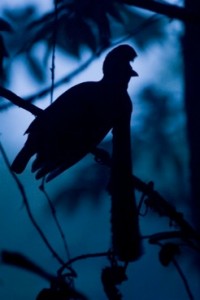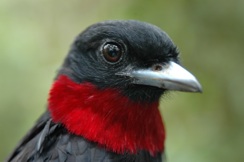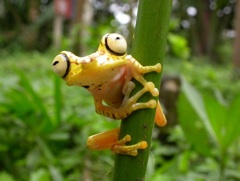Much of our work on threatened species takes place in the Ecuadorian Chocó in close collaboration with our partner organization FCAT. We characterize basic biology and conservation requirements to allow coherent and effective conservation planning. We have generated novel information on home range size, habitat preference, breeding biology, nest site selection, and social organization for endangered species like the Banded Ground-cuckoo Neomorphus radiolosus, the Brown Wood Rail Aramides wolfii and the Long-wattled Umbrellabird Cephalopterus penduliger. This ongoing research complements earlier work on endangered species in other parts of the globe, including macaws in the Amazon, grasswrens in Mallee shrub of South Australia, and trogons in southeastern Arizona.
Related Publications
2017
Botsch, J.C, S.T. Walter, S.T., J. Karubian, N. González, E. Dobbs, and B.J. Brosi. 2017. Impacts of forest fragmentation on orchid bee diversity (Hymenoptera: Apidae: Euglossini) in the Chocó biodiversity hotspot of northwest Ecuador. Journal of Insect Conservation 21: 633-643. PDF
2016
Browne, L. and J. Karubian. 2016. Diversity of palm communities at different spatial scales in a recently fragmented tropical landscape. Botanical Journal of the Linnean Society. 182: 451-464. PDF
2015
Karubian, J., K. Otwell, A.Link, and A. DiFiori. 2015. Genetic consequences of seed dispersal to sleeping trees by spider monkeys. Acta oecologica 68:50-58. PDF
2015
Browne, L., M. Gonzalez, and J. Karubian. 2015. Biodiversity in forest fragments of the Mache-Chindul Reserve. Quito, Ecuador. PDF
2014
G. F. M. Jongsma, R. W. Hedley, R. Durães, and J. Karubian. 2014. Amphibian Diversity and Species Composition in Relation to Habitat Type and Alteration in the Mache–Chindul Reserve, Northwest Ecuador. Herpetologica 70(1):34-46. PDF
2013
Carrasco, L., Berg, K. S., Litz, J., Cook, A. and J. Karubian. 2013. Avifauna of the Mache-Chindul Reserve, northwest Ecuador. Neotropical Ornithology 24: 331-324. PDF | Appendix
2013
Karubian, J. 2013. Award for Excellence in Tropical Biology and Conservation. Biotropica 45(6) 772-773. PDF | Web
2013
Durães, R., Carrasco, L., Smith, T. B., and J. Karubian. 2013. Relative effects of forest degradation versus fragmentation on avian communities in a Neotropical biodiversity hotspot. Biological Conservation 166: 203-211. PDF
2013
Kraul, C. 2013. Ecology in Action. Tulanian Magazine. PDF – News piece on work in Ecuador
2013
Hinton, M.G., A. Bendelow, S. Lantz, T.W. Wey, L. Schoen, R. Brockett, and J. Karubian. 2013. Patterns of aggression among captive American Flamingos (Phoenicopterus ruber). Zoo Biology. PDF
2012
Mila, B., E.S. Tavares, A.M. Saldana, T.B. Smith, J. Karubian and A.J. Baker. 2012. A trans-Amazonian screening of mtDNA reveals deep intraspecific divergence in forest birds and suggests a vast underestimation of species diversity. PloS One 7: e40541. doi:10.1371/journal.pone.0040541 PDF
2012
Karubian, J., R. Durães, J. Storey, and T.B. Smith. 2012. Mating behavior drives seed dispersal in the long-wattled umbrellabird Cephalopterus penduliger. Biotropica 44: 689-698. PDF *Recipient: 2013 Award for Excellence in Tropical Biology & Conservation
2011
Karubian, J., L. Carrasco, P. Mena, J. Olivo, D. Cabrera, F. Castillo, R. Durães, and N. El Ksabi. 2011. Nesting biology, home range, and habitat use of the brown wood-rail (Aramides wolfi) in northwest Ecuador. Wilson Journal of Ornithology 123: 137-141. PDF
2011
Karubian, J. 2011. The Long-wattled Umbrellabid: the feathered gardeners of the Choco. Terra Incognita 72: 8-18. (July 2011) PDF
2010
Karubian, J. 2010. Pompadours in the palms. Natural History Magazine. 119: 28-32. (February 2010) PDF
2009
Karubian, J. 2009. The secret life of the Long-wattled Umbrellabird. El Commercio Newspaper, Ecuador (May 10, 2009) PDF
2008
Karubian, J. and L. Carrasco. 2008. Home range and habitat preferences of the Banded Ground-cuckoo Neomorphus radiolosus. Wilson Journal of Ornithology 120:205-209. PDF
2007
Karubian, J., L. Carrasco, D. Cabrera, A. Cook, and J. Olivo. 2007. Nesting biology of the banded-ground cuckoo. Wilson Journal of Ornithology 119(2):222-228. PDF
2005
Karubian, J., J. Fabarra, D. Yunes, J. Jorgenson, D. Romo, and T.B. Smith. 2005. Temporal and spatial patterns of macaw abundance in the Ecuadorian Amazon. Condor 107(3):617-626. PDF



